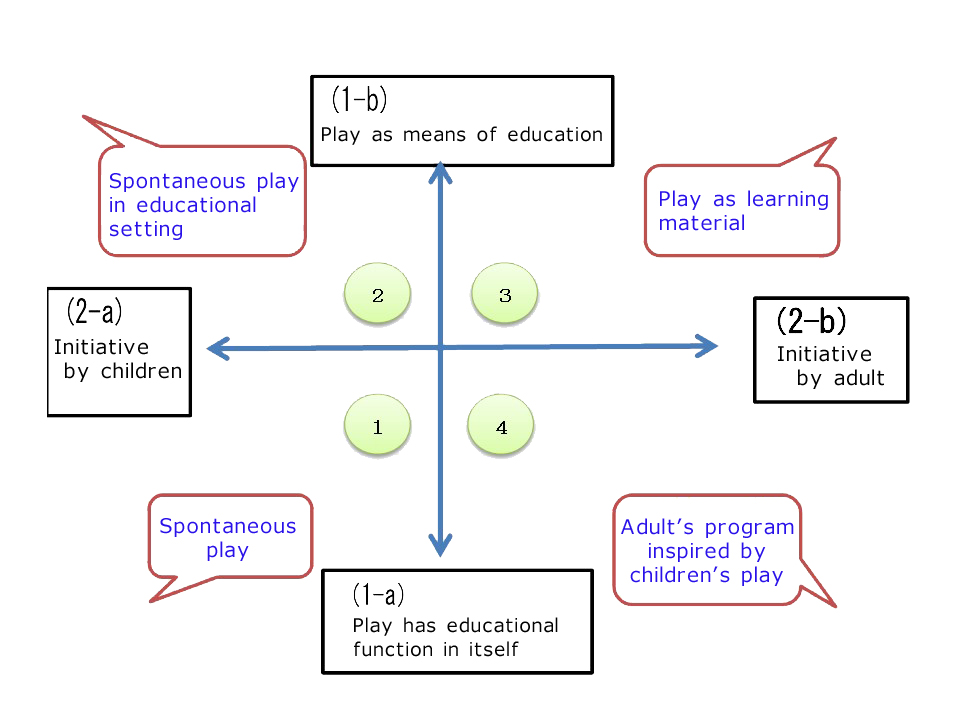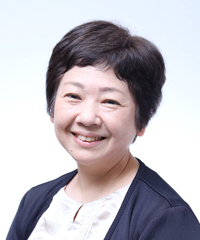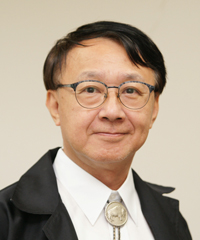Presented at the Second International Conference of Child Research Network Asia (CRNA) held in Tokyo, Japan, March 17-18, 2018.
Moderator: Nobuko Kamigaichi (Professor, Jumonji University, Japan)
Presenters: Shih-Tsung Chang (Professor, National Taipei University of Education, Taiwan), Miwako Hoshi (Professor Emerita, Jumonji University, Japan), Sopia binti Md Yassin (Director, National Child Development Research Centre, Sultan Idris Education University, Malaysia)
Kamigaichi: In this concurrent session, we will think about the relationship between children's play and their development of social and emotional skills. Children's play varies widely in terms of contents and methods ranging from free, voluntary play to educational play in early childhood education settings. Furthermore, children will have various experiences through their play. It is considered that such experiences will promote the comprehensive development of children's various abilities including social and emotional skills. Today, we invited three professors who will explain, from their respective viewpoints, how each type of play relates to the development of children's abilities and what kinds of skills are to be learned. Through their lectures and subsequent Q&A sessions, we will examine the theme of "viewing 'play' from a scientific standpoint."
First, Professor Chang will give his lecture.
"Edutainment" that identifies learning elements in entertainment (Shih-Tsung Chang)
Chang: Children's play is significantly related to four factors, that is, the objects they use (e.g., toys), the times and places they grow up in, and their peers around them. This time, I will talk about the factor of objects. Some decades ago, children used to play with simple toys made from natural materials such as wood or stone. They even made toys by themselves. Nowadays, however, such 'basic' toys are rarely seen; instead, the popularity of video games, etc. is growing.
Using hands and the brain through play tends to enhance the development of children's cognitive skills that are essential to understanding things. When children used to make 'basic' toys by themselves, they naturally used their hands thinking about the structure and usability of these toys and played with such toys considering various conditions. Nowadays, however, they do not need to think about how to make their toys as they have ready-made video games, etc., and are likely to be passive when playing such games by absent-mindedly moving their fingers.
Therefore, I suggest seeking wisdom in traditional toys and leveraging it for modern education. I also suggest that parents and grandparents play with children (three generations in a family) using conventional toys at home. According to some studies, play activities involving three generations will enhance the development of the child's brain while slowing down the brain aging of parents and grandparents. Two years ago, as part of my research activities, I hosted an exhibition displaying many toys and learning materials that could be used by children with their parents and grandparents. Among them, there was an assembly toy for constructing a "Rainbow bridge," which was developed during the Sung dynasty. Children discussed how to assemble the bridge with advice from their parents, and eventually completed its construction and were able to walk over it. It seems that children discovered various ideas with their peers while assembling the bridge, and thus strengthened a sense of unity and togetherness with their parents.
I also encourage the use of things from the viewpoint of the integration of play and learning. A typical example is the concept of "edutainment." In China and Taiwan, we refer to instructional tools used in school classes as "teaching equipment." Educational equipment is primarily designed for education, and children are required to use educational equipment even though they feel that such equipment is "not interesting." They do not use educational equipment voluntarily; therefore, their attitude towards such equipment is likely to be passive.
In contrast, toys are diametrically opposite to educational equipment. Children will choose or make a toy that interests them, and voluntarily and independently play with it without the interference of teachers. I focus on tools positioned between educational tools and toys, and call it a "learning toy." Using such a learning toy, children can enjoy playing and learning while developing various skills. A play activity using learning toys is called "edutainment," a combination of entertainment (as "means") with education (as "ends"), which means to "develop learning competencies through play activities."
I will explain one example of edutainment. I created a 3D puzzle depicting the skeleton of an elephant to help children learn about the anatomy of animals. Children can learn the physical structure of the elephant while enjoying assembling the puzzle pieces. In this case, teachers do not provide any instructions for children or specify their errors. If children make a mistake in assembling the puzzle pieces, the shape of the elephant will be distorted or out of shape; therefore, children will eventually recognize their error and try to re-assemble the puzzle. This "self-correction function" is essential while designing an interactive exhibit, for it helps participants to play and learn by themselves without other's guidance.
In edutainment, the relationship between children and adults is essential. Adults may provide play environments and learning toys. What should not be forgotten is that children take the initiative in play and adults simply provide support for children and observe them carefully. In this way, children voluntarily think and determine how to play. Even if they make a mistake while playing, they will correct the method of play by themselves. In other words, children can learn from making mistakes, and children independently enjoy and engage in play. This independence will motivate children to achieve their goals enthusiastically.
It is also important to let children use their hands. In the current school education system, watching and listening seem to be valued over speaking and using their hands. However, I believe that touching things and creating something using their hands in the classroom has considerable significance. A children's museum in Washington DC uses a slogan which says "I hear, and I forget; I see, and I remember; I do, and I understand." It's derived from an old Chinese proverb, and something which I wholeheartedly agree with.
"Where to place and how to value play in ECEC" affects children's play activities significantly (Miwako Hoshi)
Hoshi: I will explain four perspectives under the theme of "viewing 'play' from a scientific standpoint." The first standpoint is that playing is an innate nature of the human being as animal. According to the past studies, it is revealed that humans learn various survival skills through play. Newborn babies quickly learn licking and sucking on fingers and acquire the skill to obtain proper nutrition. A few months later, babies become interested in other individuals around them and start communicating with them. Our research team observed infants from two-month-old at a daycare center over a long period of time to understand how they learn to play without the interference of adults. By the time they become three months old, they observe their peers' play, reach out to them, and share toys with them. Gradually, they exhibit aspects of social behavior such as cooperating, competing, and giving in, as well as some emotional reactions such as sharing laughter and teasing. Therefore, it is considered that children have a natural ability to develop social and emotional skills through play.
The second perspective is that "adult's view on child's play is culture-dependent." This varies according to countries and cultures. For example, in Japan, the culture of childcare emphasizes play, just as it is shown in some Japanese Ukiyo-e (i.e., woodblock prints of the Edo period) depicting children playing with adults. Even in the current childcare facilities, we often see teachers participating in children's play activities. In contrast, it seems that childcare workers in South Europe such as France and Italy will carefully observe children rather than playing with them. For example in French preschools and daycare centers, activities are centered to learning rather than play activities. Some preschools provide morning lessons even for children aged three years. Children can go outside to play at break time, but play activities will never be included in curricula. In sum, in countries with a childcare-culture focusing on play, their activities involve play, while in countries not having such a culture, learning is considered to be more important. I imagine these differences among various cultures may significantly affect children's play.
The third perspective is "Where to place and how to value children's play in ECEC." The positioning of play varies according to the times, social backgrounds, cultures and values of teachers and parents. I created a matrix table summarizing the above factors (Figure 1), with which we will proceed with further discussions. The vertical axis shows the relationship between "play" and "education." The lower half of the matrix table indicates the concept of play having educational functions in itself, while the upper half of the matrix indicates the concept of play as means of education. The horizontal axis shows who leads the play. The left half of the table indicates the concept of play initiated by children, while the right half of the table indicates the concept of play initiated by adults.

Figure 1
This matrix table suggests four patterns in positioning play. Each pattern has its strength and points to consider, respectively. For example, the lower left quadrant indicates the stance of focusing on both play and children's initiative. Children will experience various relationships and emotions through voluntary play, which will contribute to the development of their social and emotional skills. On the other hand, however, there is the risk of their play becoming disorganized if children take the complete initiative, which may prevent the development of abilities to control emotions or social activities. Therefore, it is important to consider how adults provide support for children.
Now, let's think about the fourth perspective, "differences and similarities of play in ECEC in different countries and the impact of socio-cultural factors" based on the matrix table. Where is your country's ECEC located in the matrix? For example, childcare in Europe is based on Christian culture; hence there are common aspects of ECEC among European countries even though natural environments, social/economic conditions, and political conditions are different. I wish we can discuss an appropriate approach to play that enhances the development of social and emotional skills by identifying characteristics and common issues in ECEC among Asian countries.
Lastly, I will talk about "social and emotional developments" which is the basis for social and emotional skills. I once read a book written by Simone Veil, a French politician. This book made me think about the importance of social and emotional developments, as Veil's description of her existential experience of living in the Auschwitz concentration camp was extraordinary. She recalled that she was able to survive unimaginable horrors because she found a few people whom she could trust, and she did not lose faith in people even in that impossibly harsh environment.
She also said that this faith in humanity came from her happy childhood surrounded by whole-hearted family and friends. I believe that when children experience the feeling of happiness and enjoyment with specific friends through interactions with various people, they gradually acquire their view of human nature, which will lead to social and emotional developments.
Play enhances the neuronal circuitry of the prefrontal cortex (Sopia binti Md Yassin)
Sopia Yassin: I will explain two aspects of play, that is, "How play affects the development of the brain" and "Abilities developed through play." First, let us examine how play affects the brain. The brain development of children starts immediately after they are born. While their visual, hearing and verbal abilities are gradually developing, the brain will be able to process more and more complex information and a high level of cognitive functions will be acquired. It is also understood that the processing capacity of children's brain will be enhanced if provided with stimulating environment and materials for play are given to children from an early stage of childhood.
Experiences are essential for the brain development of children. For example, when a baby makes a certain movement or facial expression to his/her mother and the mother responds to the baby, the brain development of the baby will be accelerated. In contrast, if the mother does not respond to the baby's action, or inflicts harmful stress (such as abuse) on the baby, the development of the baby's brain will be affected. According to some studies, it is revealed that such negative impacts will affect the learning, behavioral, physical and mental skills of children over a long period of time.
Then, how does the brain evolve through play? According to past studies, it is understood that play can positively stimulate the connection between the neuronal circuitry in the prefrontal cortex. When the neuronal circuitry of the prefrontal cortex is developed, it is possible to effectively control emotions, solve problems, and take appropriate actions according to situations. Some studies reported that significant changes were identified in the weight and efficiency of the brain of children, who were under study and given toys to play with for two hours per day. It is also confirmed that sound development of the brain requires free, independent play without rules or instructions imposed by someone. This type of play is also called "messy play". When children engage in messy play exercising their abilities to the maximum extent possible, the development of their brain will be accelerated.
Next, I will talk about the "abilities developed through play." I am currently conducting a research study under the theme of "Children's Inquiry Through Play" at the National Child Development Research Centre of Sultan Idris Education University in Malaysia. The study targets those children aged five years attending a kindergarten organized by the research center. Various activities are to be provided for the children based on specific curriculums according to their interests.
For example, the question "Why do I need to wash my hands?" stimulated children's curiosity to learn about the effect of washing their hands with soap. In the end, the children decided to do a project on making a bar of soap by themselves. By finding out the necessary ingredients to make a bar of soap, measuring the amount of each ingredient, and making soap of various colors, the children successfully conducted the integrated activity across different learning areas. The project also incorporated creative play elements such as blending plant stems and leaves into the soap. This approach also included other activities such as investigating molds on food, researching the growth environment of earthworms, and making organic compost from kitchen waste.
These exploratory activities inspired by children's "why" questions often lead to cross-disciplinary integrated curriculum such as Science Technology Engineering and Mathematics (STEM). Through these activities, children can acquire broad and deep knowledge by enjoying solving problems and increasing their curiosity through play. In other words, play helps children develop their diverse abilities.
Having a "Playful Spirit" is a key to foster a "Zest for Living"
Kamigaichi: Now, please ask questions.
Questioner A: About the "learning toys" mentioned by Professor Chang, what kind of learning toys should childcare workers and teachers use?
Sopia Yassin: I recommend that you use organic learning toys for young children. For example, a little girl I saw made a suitcase using a paper box and played the role as a flight attendant. Although the suitcase did not have wheels, the girl enjoyed pretending that she was walking in the airport terminal with her suitcase. I believe that organic materials will inspire children's imaginative play to a great extent.
Questioner B: I am a mother raising two children. I sometimes find difficulty in deciding whether my children are playing "Messy Play" as mentioned by Professor Sopia, or "disorganized play" as mentioned by Professor Hoshi. For example, when they played with scissors cutting origami paper, they first cut the paper in an orderly manner, but eventually tore it into small pieces and spread them around the floor. What should I think this might mean?
Hoshi: It is important to check whether their eyes are alight with amusement when they are playing. There are many cases where adults consider it as disorganized play while children consider it as creative play using their imaginative power. If they get bored with play or feel reckless, their facial expression will surely indicate it.
Kamigaichi: Lastly, I would like to close this concurrent session by summarizing Professor Hoshi's matrix table. Before that, I would like to have comments from the professors, if any.
Sopia Yassin: The first three years are very important for children's development. It is essential that parents and teachers understand what is happening in the children's brain starting from when they are involved in solitary play until when they acquire social skills to play with their peers. In addition, it is important for children to be involved in physical activities to ensure their holistic development. Adults may provide support for children especially with outdoor activities, taking advantage of opportunities where children can freely move inside and outside the classroom and teaching them the concept of space by saying "You are in a tunnel" and so on. In metropolitan areas, it is becoming more difficult to find a suitable place where children can play outside. Nevertheless, I recommend that you provide an environment, even indoors, where children can move freely as much as possible.
Chang: We consider a child as a seed that requires sunlight and water to grow as well as an environment with abundant nature. When adults try to promote play initiated by children, it is vital for them to take on three roles simultaneously, that is, "providing support for children," "playing with children," and "sharing experiences with children." While keeping your intentions clear, you should appropriately switch between these roles from one to another according to the situation.
Hoshi: The research team, in which Professor Kamigaichi and I participate, is currently conducting a research study on early childhood education and care in Pistoia in middle Italy. In Pistoia, teachers observe play activities initiated by children and create curriculums based on the results of observation. I mentioned this study because it has numerous aspects common to today's theme in terms of "play initiated by children."
Kamigaichi: Today's theme was not easy, but all the ideas and thoughts explained by the professors were related to the quadrants (1) and (4) shown on Professor Hoshi's matrix table. This indicates that play itself is valuable. Another common aspect is "play initiated by children." In sum, it is important for adults not to provide children with an opportunity of play as means of education, but to carefully observe children while they are freely and voluntarily playing and fulfill a required role according to situations.
Furthermore, play not only helps children develop social and emotional skills but also tends to foster a "zest for living" to live a happy and productive life. To achieve this, I believe that having a "playful spirit" is a requirement for both adults and children. The professors explained the importance of fostering a "playful spirit" that seeks fun and enjoyment as well as the importance of natural environments, actual experiences, physical abilities and good interactions with the environment.



 Nobuko Kamigaichi
Nobuko Kamigaichi Shih-Tsung Chang
Shih-Tsung Chang Miwako Hoshi
Miwako Hoshi Sopia binti Md Yassin
Sopia binti Md Yassin










